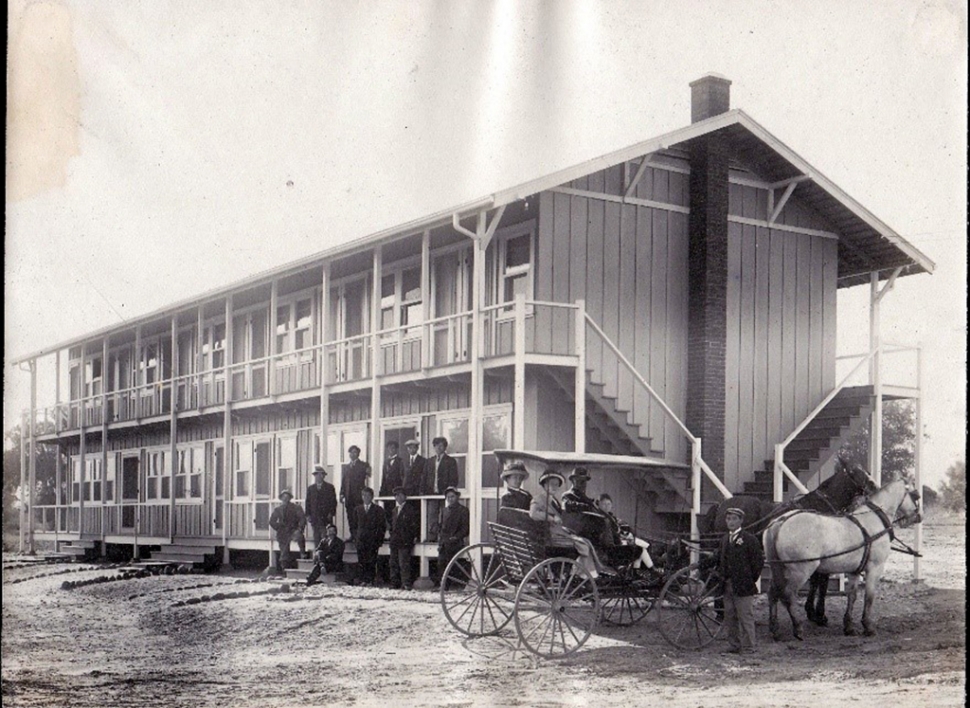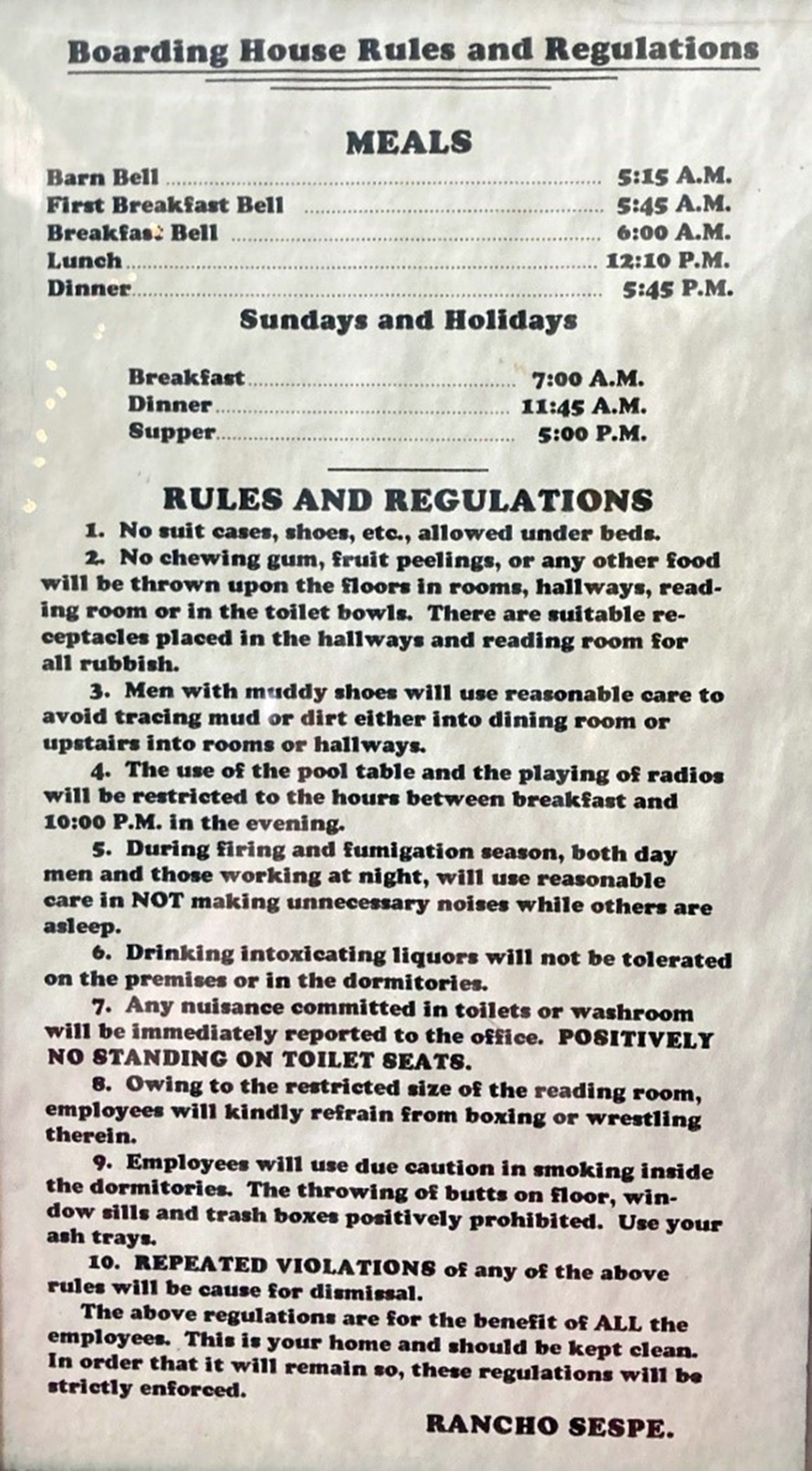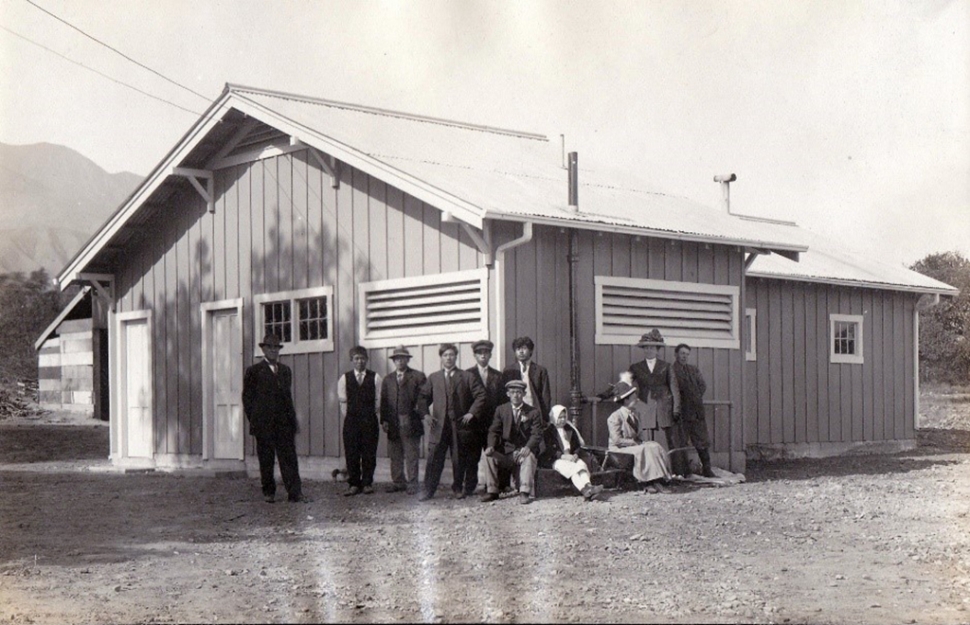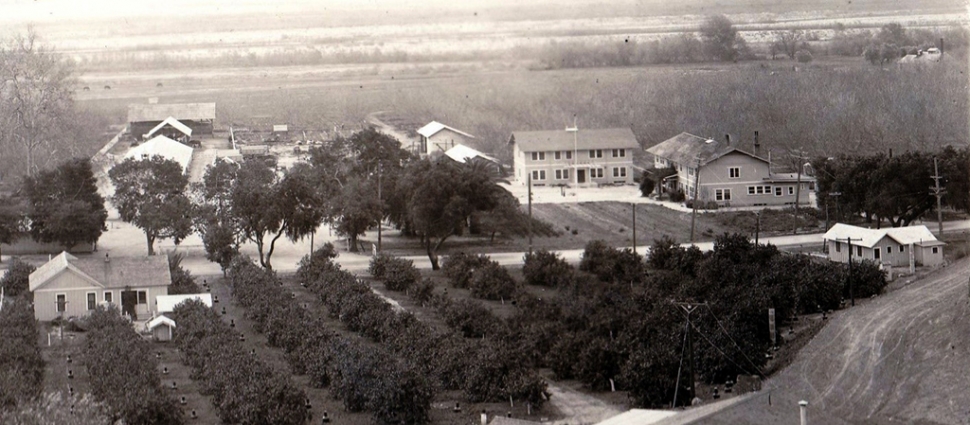|
Rancho Sespe Bunkhouses
By Gazette Staff Writers — Thursday, December 16th, 2021
 Japanese bunkhouse/dormitory, circa 1914. The bunkhouse housed unmarried Japanese workers, and the dormitory was opened to the outside rather than to an interior hall. Photos courtesy Fillmore Historical Museum.  Bunkhouse Rules  Japanese bathhouse 1914.  Rancho Sespe Headquarters with Bunkhouse #2 facing north and Bunkhouse #1 facing east, circa 1925. Courtesy Fillmore Historical Museum The Rancho Sespe Bunkhouse #2 is one of thebuildings at the Fillmore Historical Museum and houses a major portion of our collection. It was moved to its current site in 1995 having been donated to the Museum by James P. Finch who had bought the Rancho Sespe headquarters parcel. As the name implies, this was not the first bunkhouse on Rancho Sespe, in fact it was the third. All of the bunkhouses were built while the property was owned by Eudora Hull Spalding who had inherited half the property from her father and had subsequently bought out her brother’s share and became the sole owner of the 2,200 acre tract. By the time of her death in 1942 the ranch had been expanded to 4,300 acres and had become an internationally known showcase for its advances in citrus cultivation. Besides citrus, it grew walnuts, hay, beans and other crops as well as including pasture lands for its horses and cattle. It was a self-contained community which employed over 200 people. From 1911 to 1919 three bunkhouses were built to house unmarried workers. The architecture firm of Greene and Greene of Pasadena was hired to design Rancho Sespe Bunkhouse #1 which still stands at the former headquarters site approximately 4 miles west of Fillmore. The actual design was probably done by a draftsman at the firm which was best known for designing Craftsman style bungalows such as the Gamble House in Pasadena and not utilitarian bunkhouses. The primary builder of the bunkhouse was Harry Peyton who had come to Fillmore with the Southern Pacific Railroad. In the March, 1918 edition of California Citrograph, Sespe Ranch Manager Walter H. Fleet described the bunkhouse as a“two-story building, 80ft. by 45 ft., and consists of a large living room, dining room for the general class of employees, private dining room for officials, kitchen, washroom, three bathrooms, three toilets, linen room, storeroom and 20 separate sleeping rooms on the second floor…. Each room has a large window and is furnished with following: one iron bed and springs, one mattress, two sheets, two blankets in summer and three in winter, one pillow, one white pillow cover, one bedspread, one chair, one table and closet with a curtain as dust protector…. Clean sheets for the beds are furnished twice a week, and clean towels in the washroom are furnished every day…, Hot water for the baths is furnished twice a week. The method of heating is by stove distillate burners, which heat a 200 gallon tank very quickly. In the living roomthere are card tables, a large library billiard table and large wood heating stove.” For its time, the Rancho Sespe Bunkhouse #1was an especially comfortable bunkhouse with modern conveniences. We do not know as much about the second dormitory’s history but know it was built by 1914. This bunkhouse housed unmarried Japanese workers. The dormitory was similar to Bunkhouse #1, but the rooms opened to the outside rather than to an interior hall. Again according to Walter Fleet: “The building contains a living room, dining room, large kitchen with Japanese cook stoves, 10 sleeping rooms upstairs and four downstairs….The ranch furnishes one bed and springs, one mattress, one table, one chair. The occupants furnish their own bedding and board themselves. In the dining room are two long tables and seating benches for 50 people. One feature of the Japanese quarters is their large bathhouse. This building is 40 ft. by 27 ft. with cement floor throughout. Here are located the toilets and washroom, and in the center is a large concrete tank for bathing 10 ft. by 3 ft. deep. Hot water is furnished by a wood or oil heater which heats a tank of 300 gallons. There are also two shower baths in the building.” The third bunkhouse, Rancho Sespe Bunkhouse #2 which now is part of our Museum, was built in 1919. Again we believe that Harry Peyton was the primary carpenter but this has not been confirmed. The twenty-eight sleeping rooms were similar to the ones in Bunkhouse #1. Toilet facilities were provided in Bunkhouse #2, but the workers used the dining, recreation and shower facilities in Bunkhouse #1. In 1937, Edward Wyman Spalding, a cousin of Keith Spalding, had just gotten out of the Navy and came to work as a ranch hand at Rancho Sespe. He lived in one of the bunkhouses and in the Ventura County Historical Quarterly, Volume 38, 1993, described the experience thusly: “We all breathed the same air. And heard the same sounds. At least on Sundays. Each of the other men, it seemed, had his own radio, little things – we’d call them antiques now – and all through the week when we weren’t at work, each of those radios would have its own music, what we’d call “country” now. It was fairly chaotic. But not on Sunday. Sunday all of those little jobs would be tuned to Aimee Semple MacPherson’s “Foursquare Church,” and Aimee’s voice would be echoing off the rafters. Loud. Very Loud.” Change the music being played and the Sunday sermon, and it sounds very much like a college dormitory. |
